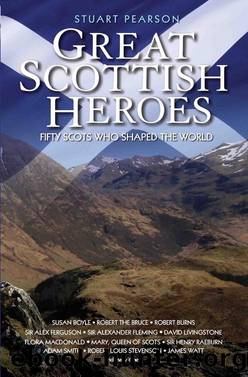Great Scottish Heroes--Fifty Scots Who Shaped the World by Stuart Pearson

Author:Stuart Pearson [Stuart Pearson]
Language: eng
Format: epub
ISBN: 9781784186135
Publisher: John Blake Publishing
Published: 2015-10-15T00:00:00+00:00
SIR DAVID BREWSTER (1781â1868)
INVENTOR, MATHEMATICIAN, PHYSICIST AND SCIENCE WRITER
David Brewster was born in Jedburgh in the Scottish Borders. His father was rector of the local grammar school and a teacher of considerable reputation. The entire family was gifted intellectually, though David, who was the third of six children, was recognised as a child prodigy. He was sent to Edinburgh University at the age of twelve to study divinity like his three brothers, who all became ministers.
Although he graduated in divinity and in fact preached at least one sermon, his preference was inclined towards unravelling the mysteries of the natural world. He altered his pursuits from religion to science, with a special interest in optics and mathematics.
His early work concentrated on the diffraction of light, then a little-known field of science, and to his surprise, his energetic, intelligent, scholarly approach led to several discoveries that were published in a number of scientific journals. This resulted in Brewster becoming noticed by the international scientific community. He then confirmed his growing reputation by defining a set of laws that govern how light behaves.
In 1811, after years spent investigating light refraction and reflection through glass, minerals and crystals, seeking a general law of light polarisation, Brewster made a discovery that would ultimately have life-saving implications. He constructed a series of stepped lenses of then unequalled quality for power and brilliance. The polyzonal lenses, as they were called, magnified rays of light so powerfully they would lead to the birth of the modern lighthouse as we know it today. The lens is now known as a Fresnel lens, after the French inventor who â unknown to Brewster â developed the same kind of lens at about the same time. Although Augustin Fresnel was slightly behind Brewster, the French authorities were quick to use the lenses in their lighthouses, while the British Lighthouse Boards were slow to adopt them.
Brewster was admitted to the Royal Society in 1815; he was awarded a prize in 1816 by the French Institute for his work on light polarisation; and he was elected to the premier scientific societies of a number of European countries.
He went on to discover a simple way to calculate the optimum angle for light polarisation: Brewsterâs Angle is useful in all kinds of practical applications, from adjusting radio signals to building microscopes capable of examining objects on a molecular scale.. Further, the phenomenon of light diffraction he pioneered gave birth to the commercially valuable field of optical mineralogy â the study of minerals and rocks by measuring their optical properties.
Brewsterâs contributions to the field of optics led him to be dubbed the âFather of modern experimental opticsâ. Two of his more light-hearted inventions have brought much joy to adults and children alike for almost two centuries â the kaleidoscope and the stereoscope (where two images of the same object became one three-dimensional object when viewed through the device). Both these inventions caused a sensation when released commercially. However, he did not receive any financial reward for these
Download
This site does not store any files on its server. We only index and link to content provided by other sites. Please contact the content providers to delete copyright contents if any and email us, we'll remove relevant links or contents immediately.
| France | Germany |
| Great Britain | Greece |
| Italy | Rome |
| Russia | Spain & Portugal |
Fanny Burney by Claire Harman(26492)
Empire of the Sikhs by Patwant Singh(22912)
Out of India by Michael Foss(16758)
Leonardo da Vinci by Walter Isaacson(13114)
Small Great Things by Jodi Picoult(6878)
The Six Wives Of Henry VIII (WOMEN IN HISTORY) by Fraser Antonia(5365)
The Wind in My Hair by Masih Alinejad(5014)
A Higher Loyalty: Truth, Lies, and Leadership by James Comey(4803)
The Lonely City by Olivia Laing(4715)
The Crown by Robert Lacey(4695)
Millionaire: The Philanderer, Gambler, and Duelist Who Invented Modern Finance by Janet Gleeson(4309)
The Iron Duke by The Iron Duke(4258)
Papillon (English) by Henri Charrière(4155)
Sticky Fingers by Joe Hagan(4071)
Joan of Arc by Mary Gordon(3987)
Alive: The Story of the Andes Survivors by Piers Paul Read(3929)
Stalin by Stephen Kotkin(3831)
Aleister Crowley: The Biography by Tobias Churton(3540)
Ants Among Elephants by Sujatha Gidla(3369)
